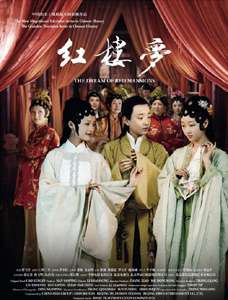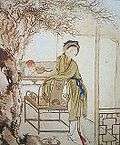The Dream of Red Mansions (2010 TV series)
The Dream of Red Mansions (Chinese: 红楼梦) is a 2010 Chinese television series, produced by Han Sanping and directed by Fifth Generation director Li Shaohong. It is a new adaptation of the classic novel Dream of the Red Chamber. The series, comprising 50 episodes, made its debut on 6 July 2010 on 9 terrestrial networks across China.[1]
| The Dream of Red Mansions | |
|---|---|
 Official poster | |
| Genre | Romance Drama |
| Based on | Dream of the Red Chamber by Cao Xueqin |
| Directed by | Li Shaohong |
| Creative director(s) | Ye Jintian |
| Starring | Yang Yang Jiang Mengjie Li Qin Michelle Bai Yao Di Zhou Caiqin Gua Ah-leh Ma Xiaocan |
| Country of origin | China |
| Original language(s) | Mandarin |
| No. of episodes | 50 |
| Production | |
| Producer(s) | Han Sanping |
| Running time | 45 minutes per episode |
| Release | |
| Picture format | 16:9 HD |
| Original release | 6 July 2010 |
| The Dream of Red Mansions | |||||||
|---|---|---|---|---|---|---|---|
 Intertitle | |||||||
| Simplified Chinese | 红楼梦 | ||||||
| Traditional Chinese | 紅樓夢 | ||||||
| Hanyu Pinyin | Hónglóu Mèng | ||||||
| |||||||
Cast
- Yang Yang as Jia Baoyu
- Yu Xiaotong as young Jia Baoyu
- Jiang Mengjie as Lin Daiyu
- Lin Miaoke as young Lin Daiyu
- Michelle Bai as Xue Baochai
- Li Qin as young Xue Baochai
- Yin Yezi as Xue Baoqin
- Xu Lu as young Xue Baoqin
- Yao Di as Wang Xifeng
- Yang Mi as Qing Wen
- Zhao Liying as Xing Xiuyan
- Huang Xuan as Xue Ke
- Song Yi as Xiangling
- Zhou Caiqin as Grandmother Jia
- Ding Li as Jia Tanchun
- Ma Xiaocan as Shi Xiangyun
- Zhang Di as Jia Yingchun
- Xu Xing as Jia Xichun
- Tang Yifei as Qin Keqing
- Cheng Yuanyuan as Ping'er
- Ye Linlang as Granny Liu
- Li Yan as Xiren
- Gao Liang as Jia Lian
- Gua Ah-leh as Lady Wang
- Wu Xiaodong as Jia Yun
- Yang Junyong as Jia Rong
- Wang Fuli as Lady Xing
- Jia Ni as Lady You
- Gao Yang as Miaoyu
- Cai Feiyun as Yuanyang
- Xu Huanshan as Jia Zheng
- Xuan Lu as Xue Yan
- Kan Qingzi as She Yue
Production
The series was one of the most expensive Chinese TV series ever made at RMB118 million (US$17.55 million).[2] Unlike the 1987 version, this series adapts the Cheng-Gao version. The 2010 series reproduces large segments of the book's pre-modern Beijing dialogue, often in full.[3] Another feature is its heavy use of a male voice-over reciting much of the book's narrative.
The director was originally slated to be Hu Mei, but Hu clashed with the producers over the cast selection, and was replaced by Li Shaohong in October 2007.[4][5] The 2010 TV series faced controversy over its cast, the stylized, kunqu-inspired hairdo, as well as a generally negative press after its July 6 debut.[6][3]
Reception
The 2010 remake was controversial from the start, since the 1987 version was highly acclaimed and few critics were convinced a modern version will match its predecessor. Following a highly publicized casting call, director Hu Mei was replaced by Li Shaohong in 2007. Li courted more controversy by adopting a stylized kunqu-inspired hairstyle (dubbed "coined heads" 铜钱头/銅錢頭 (Tóngqián tóu) by netizens) for her female cast members, as advised by Hong Kong art director Ye Jintian. Many viewers find the hairstyle grotesquely unrealistic.[7][8]
Response to the series after its debut was mixed,[9] but was largely negative.[10] It was panned by some newspapers,[11][12] with one referring to it as a pre-modern version of the pop idol drama Meteor Garden.[13] Audience expressed dismay over its use of music,[4] and the use of make-up was also criticized. Some Redologist scholars voiced their disappointment with the somewhat juvenile acting and script adaptation.[14] Director Li was under enormous pressure owing to the negative feedback and broke down during a Beijing press conference held on 7 July 2010, her birthday.[8]
Awards and nominations
| Year | Award | Category | Nominated work | Result | Ref. |
|---|---|---|---|---|---|
| 2010 | 2nd China TV Drama Awards | Best Producer | Li Xiaowan | Won | |
| Best New Actress | Jiang Mengjie | Won | |||
| 2011 | Seoul International Drama Awards | Popular Actor Award | Yu Xiaotong | Won |
References
- "记者说"红楼" 新版《红楼梦》群起而看之(图)". Book.ce.cn. Retrieved 2011-10-25.
- "新《红楼》8年耗资1.18亿 投资方称年收益率低_网易娱乐". Ent.163.com. Retrieved 2011-10-25.
- F_363. "Nightmare of Red Mansions". People's Daily. Retrieved 2011-10-25.
- "新版《红楼梦》启动 李少红接替胡玫原因有三(图)_中国网". China.com.cn. 2007-10-31. Retrieved 2011-10-25.
- "新《红楼梦》造型三大硬伤 铜钱头苍白脸很另类_娱乐_腾讯网". Ent.qq.com. Retrieved 2011-10-25.
- ""人民公敌"李少红? 新版《红楼梦》的六宗罪_网易娱乐". Ent.163.com. 2010-09-02. Archived from the original on 2012-03-10. Retrieved 2011-10-25.
- "四川在线:新《红楼梦》再续辉煌还是恶俗炒作_网易娱乐". Ent.163.com. Retrieved 2011-10-25.
- "人民日报:李少红和新《红楼》该如何面对批评_网易娱乐". Ent.163.com. 2010-08-05. Retrieved 2011-10-25.
- "新京报系列评论:李少红上了红学家的当_网易娱乐". Ent.163.com. 2010-09-07. Retrieved 2011-10-25.
- "今日早报:这款《红楼梦》更像《西游记》_网易娱乐". Ent.163.com. 2010-07-27. Retrieved 2011-10-25.
- "京华时报:新《红楼梦》满眼荒唐剧不见辛酸戏_网易娱乐". Ent.163.com. 2010-09-09. Retrieved 2011-10-25.
- "演员素质低 红学家提起新红楼气不打一处来_雅虎文化". Yahoo!. 2010-07-06. Archived from the original on 2011-07-18. Retrieved 2011-10-25.
External links
- The Dream of Red Mansions, CNTV online complete video, free and legal streaming (Chinese)
- The Dream in Red Mansions on IMDb
- Ent.163.com site
